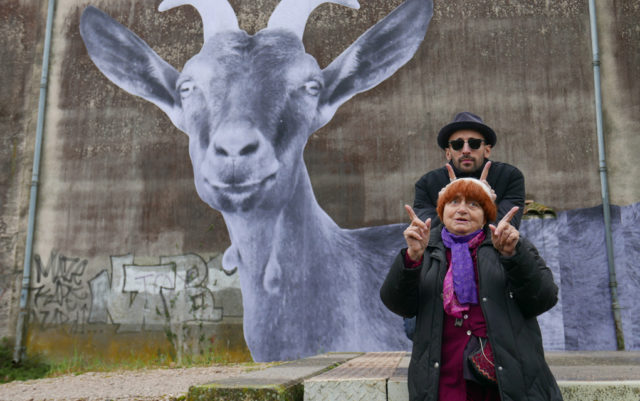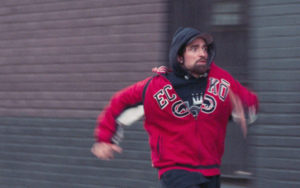
If the whole of 2017 could be summed up in one cinematic moment, then that moment would not be found in the cinema but on TVs, tablets, laptops and phones. And it would not be a moment of illuminating comprehension, sudden compassion or transcendent empathy; it would be of utter confusion and total frustration.
That moment belongs to Twin Peaks: The Return, David Lynch’s 17-hour movie/miniseries that debuted at the Cannes Film Festival before running its course every Sunday on Showtime.
In the show’s final scene, FBI Special Agent Dale Cooper (or what we hope is FBI Special Agent Dale Cooper) tries to set a fractured world right by taking Twin Peak’s living dead girl, Laura Palmer, back to her childhood home 25 years after her highly publicized death. The problem: she might not be Laura Palmer and this might not be 25 years later.
It’s an odd scene, one that doesn’t make sense to us watching or the characters participating. Cooper, totally confused, breaks. “What year is this?” he gasps while Laura Palmer (if she is Laura Palmer) watches silently. Her gaze drifts from Cooper to the idyllic suburban home where the most reprehensible of familial acts have transpired. Then, a whisper; the faintest of whispers descends and shakes Laura Palmer to her core. And Laura Palmer, a woman neither allowed to live nor die, screams so loud even the heavens must have heard.
Cut to black.

• • • •
To put it mildly, 2017 was not a blissful year. Every day seemed to vacillate between Cooper’s confusion and Palmer’s helpless cry at the void, and not even movies could hold the world behind theater doors. Public politics and personal problems bled into every aspect of moviegoing, from production to reception, intention to exploitation.
Some movies dealt with those problems head-on, others returned to historical moments in search of eternal truths, while a few even tried to provide whimsical and entertaining diversions. Regardless of how they found their way, all engaged with a similar question: Can movies fill you up after the world has wrung you dry?
The following movies did for this humble critic. They brought comfort to an uneasy viewer in an increasingly uneasy world.
None more so than Faces Places, the latest documentary from one of France’s greatest treasures: Agnès Varda.
Varda, who began her career in 1955, has spent a lifetime peering into the forgotten nooks and crannies of society. Not with hopes of exploitation and sensation, but with compassion and curiosity.
In Faces Places, Varda brings along 33-year-old French street photographer, JR, and the two tour the French countryside in JR’s mobile photo booth, which also prints large-format images that he flyposts on various structures.
The towns they visit are mainly blue-collar — the ones rapidly slipping into obscurity thanks to technological and economic progress — and Varda sees their job as a race against the clock. They must meet these people, hear their stories and take their pictures so “they don’t fall down the holes in my memory.”
Many of these villages — including the people who remain long after the world has left them behind — echo the same American cities that felt forgotten by the previous political administration. Had Varda and JR wanted to visit these towns seeking loudmouths, radicals, bigots and outliers they no doubt could have. Instead, Varda seeks to capture the most important and the most forgotten of these villages: the women. Be they the wives of dockworkers or the last inhabitant in a row of houses set to be demolished, Varda and JR plaster these women’s images across whole buildings and structures, honoring them with a level of celebrity that leaves them speechless.
• • • •
Roger Ebert famously called movies “empathy machines,” and it was empathy that beat back the darkness 2017 wrought. From the French countryside in Faces Places to the free-roaming cats of Istanbul in Kedi to a villa in Northern Italy where a sensual and tender love story gives Call Me By Your Name a lush and intoxicating style, these movies were enchanted by humanity and emotion. They say eyes are the windows to the soul; well, the camera’s eye widens that window 40-fold.
But even 40 wasn’t enough for Christopher Nolan, who once again made the case for event cinema with Dunkirk, a movie that took the 1940 evacuation of 300,000 Allied troops from the beaches of Dunkirk, France, and applied an angelic-like perspective. Compressing time — one week, one day and one hour all run simultaneously — and stripping characters down to their base needs, Dunkirk utilizes an omniscient point of view to observe humanity at its most dire. It’s as if the angels from Wings of Desire decided to stop by and see what all the commotion was about.

The same is true with LA 92, a documentary about the 1992 Los Angeles riots constructed entirely from archival footage. Much like Dunkirk, there are no characters to latch on to, identify with or root for — only players in an event bigger than any one person.
The results are stunning. Both Dunkirk and LA 92 are adroitly constructed — thanks in no small part to their outstanding scores — and both benefit from tension and propulsive energy, something cinema captures better than any other art form.

That propulsive energy can also be found in two street-level crime movies: Good Time and Baby Driver. The former, anchored by an outstanding lead performance from Robert Pattinson, moves through the streets of Queens, New York, like a snake slithering through a briar patch. The latter, a musical set to the beat of burning rubber and revving engines, refuses to yield, racing headfirst into certain doom. Why? Because life is just more interesting that way. The protagonists from Good Time and Baby Driver both end up in similar situations, but with very different understandings of how they got there.

And like Baby Driver, some movies are best when they bring pleasure while also touching a few raw nerves: Phantom Thread, Lady Bird and Star Wars: The Last Jedi. All are entertaining, but simple diversions? Certainly not. Whether it was post-war London, turn-of-the-century Sacramento, or a galaxy far, far away, these movies engage with everyday life in ways that are surprising and confrontational. Filmmaker Jean-Luc Godard once claimed all art was political; in 2017, all art had to be.
• • • •
There were more, so many more. Cinema in 2017 was too good for just 10: Get Out, Coco, A Ghost Story, Personal Shopper, The Florida Project, The Lost City of Z, Dawson City: Frozen Time, I, Tonya and on and on.
Many have theorized that great art can only arise from great conflict. Put another way, the artist needs something to push up against. That certainly seems to make sense (look at how many iconic American movies were made during World War II and the Vietnam War), but there might be another explanation, one that reverses the equation and instills it with action rather than reaction: In times of great conflict, great art becomes the antidote.
Lord knows we’ll need it in 2018.
Michael J. Casey’s Top 10 Movies of 2017:
Faces Places
Call Me By Your Name
Kedi
Phantom Thread
Dunkirk
Good Time
LA 92
Baby Driver
Lady Bird
Star Wars: The Last Jedi














